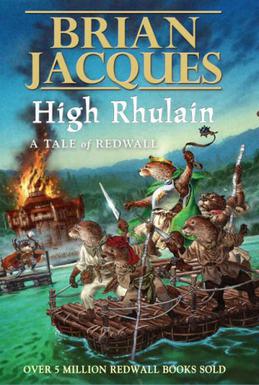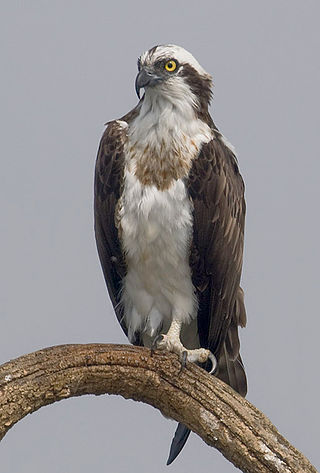
Aegeus was one of the kings of Athens in Greek mythology, who gave his name to the Aegean Sea, was the father of Theseus, and founded Athenian institutions.

The 1300s BC is a decade which lasted from 1309 BC to 1300 BC.
The 1390s BC is a decade which lasted from 1399 BC to 1390 BC.

The osprey, historically known as sea hawk, river hawk, and fish hawk, is a diurnal, fish-eating bird of prey with a cosmopolitan range. It is a large raptor, reaching more than 60 cm (24 in) in length and 180 cm (71 in) across the wings. It is brown on the upperparts and predominantly greyish on the head and underparts.
In Greek mythology, Cecrops II was the legendary or semi-legendary seventh king of Athens and in whose reign the deeds of Dionysus and Perseus occurred.
In Greek mythology, Pandion I was a legendary King of Athens, the son and heir to Erichthonius of Athens and his wife, the naiad Praxithea. Through his father, he was the grandson of the god Hephaestus.
In Greek mythology, Pandion II was a legendary King of Athens, the son and heir of King Cecrops II and his wife Metiadusa, daughter of Eupalamus.

High Rhulain is a children's fantasy novel by Brian Jacques, published in 2005. It is the 18th book in the Redwall series.

Pandion is a genus of fish-eating bird of prey, known as ospreys, the only genus of family Pandionidae. Most taxonomic treatments have regarded this genus as containing a single living species, separated into subspecies and found worldwide near water, while some treatments recognize two living species, splitting off the eastern osprey from Australia and southeast Asia.

The Sanctuary of Pandion is the name sometimes given to the remains of a building located in the south-east corner of the Acropolis of Athens. Its foundations were found during the excavations for the construction of the Old Acropolis Museum (1865–1874).

The Alfa Romeo Pandion is a concept car which premiered at the 2010 Geneva Motor Show. It was designed by Stile Bertone and the main responsibility was given to Mike Robinson. The Pandion coupé was designed as a tribute to Alfa Romeo’s centennial anniversary. The Pandion is based on the Alfa Romeo 8C Competizione sports car and shares its all-aluminium 4.7-litre (4691 cc) DOHC 90 degree V8 engine, rated at 450 PS. The kerb weight is 1,258 kg (2,773 lb).

Procne or Progne is a minor figure in Greek mythology. She was an Athenian princess as the elder daughter of a king of Athens named Pandion. Procne was married to the king of Thrace, Tereus, who instead lusted after her sister Philomela. Tereus forced himself on Philomela and locked her away. When Procne discovered her sister and her gruesome fate, she took revenge against her husband by murdering their only child, a young boy named Itys. Procne's story serves as an origin myth for the nightingale.
The Pandia was an ancient state festival attested as having been held annually at Athens as early as the time of Demosthenes. Although little that is known of the Pandia is certain, it was probably a festival for Zeus, and was celebrated in the spring after the City Dionysia in the middle of the month of Elaphebolion.
Pandion was the eponymous hero of the Attic tribe Pandionis, which was created as part of the tribal reforms of Cleisthenes at the end of the sixth century BC. He is usually assumed to be one of the two legendary kings of Athens, Pandion I or Pandion II.
Cape Blanche Conservation Park is a protected area located on the west coast of Eyre Peninsula in South Australia about 25 kilometres south of Streaky Bay. It was proclaimed under the National Parks and Wildlife Act 1972 in 2012 for the purpose of protecting ‘important breeding habitat for the eastern osprey and white-bellied sea-eagle ’ and ‘diverse range of flora’ including ‘the West Coast mintbush ,’ and to provide ‘provide important habitat for threatened shorebirds and migratory birds, including the hooded plover, sooty oystercatcher(Haematopus fuliginosus) and sanderling .’ The conservation park is classified as an IUCN Category III protected area.
Searcy Bay Conservation Park is a protected area located on the west coast of Eyre Peninsula in South Australia about 25 kilometres south of Streaky Bay.

The eastern osprey is a diurnal, fish-eating bird of prey. They live in Oceania at coastal regions of the Australian continent, the Indonesian islands, New Guinea, and the Philippines. It is usually sedentary and pairs breed at the same nest site, building up a substantial structure on dead trees or limbs. The subspecies resides in a habitat close to coasts and estuaries that provide opportunities for fishing. In 2022, it was considered a defunct species by the IOC, due to its low genetic divergences and absence in morphological differences. The eastern osprey's diet consists mostly of vertebrate fish species. It possesses specialised physical characteristics and exhibits unique behaviour to assist in hunting and catching prey.
In Greek mythology, Pandion may refer to the following characters:

Nisaea or Nisaia was the Saronic port town of the ancient polis Megara. In Greek mythology, Nisaea was founded by one of Pandion II's sons, Nisos, who named the region given to him by his father Nisaea, after himself. Control of Nisaea slipped back and forth between Athens and Megara both before and during the Peloponessian War. Athenian allies of the Megarians built long walls which connected Nisaea to Megaris. According to Thucydides, the length of the walls that connected the port to Megara were eight Greek stadia, while Strabo claims the walls to have been 18 stadia in length. A temple of Demeter was located on the road near Nisaea, and a temple of Poseidon located within the port town. Nisaean Megara is thought to have been the birthplace of poet Theognis, but his birthplace is not known for certain The location of the ancient port town remains in debate by historians.









